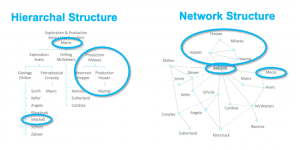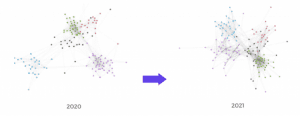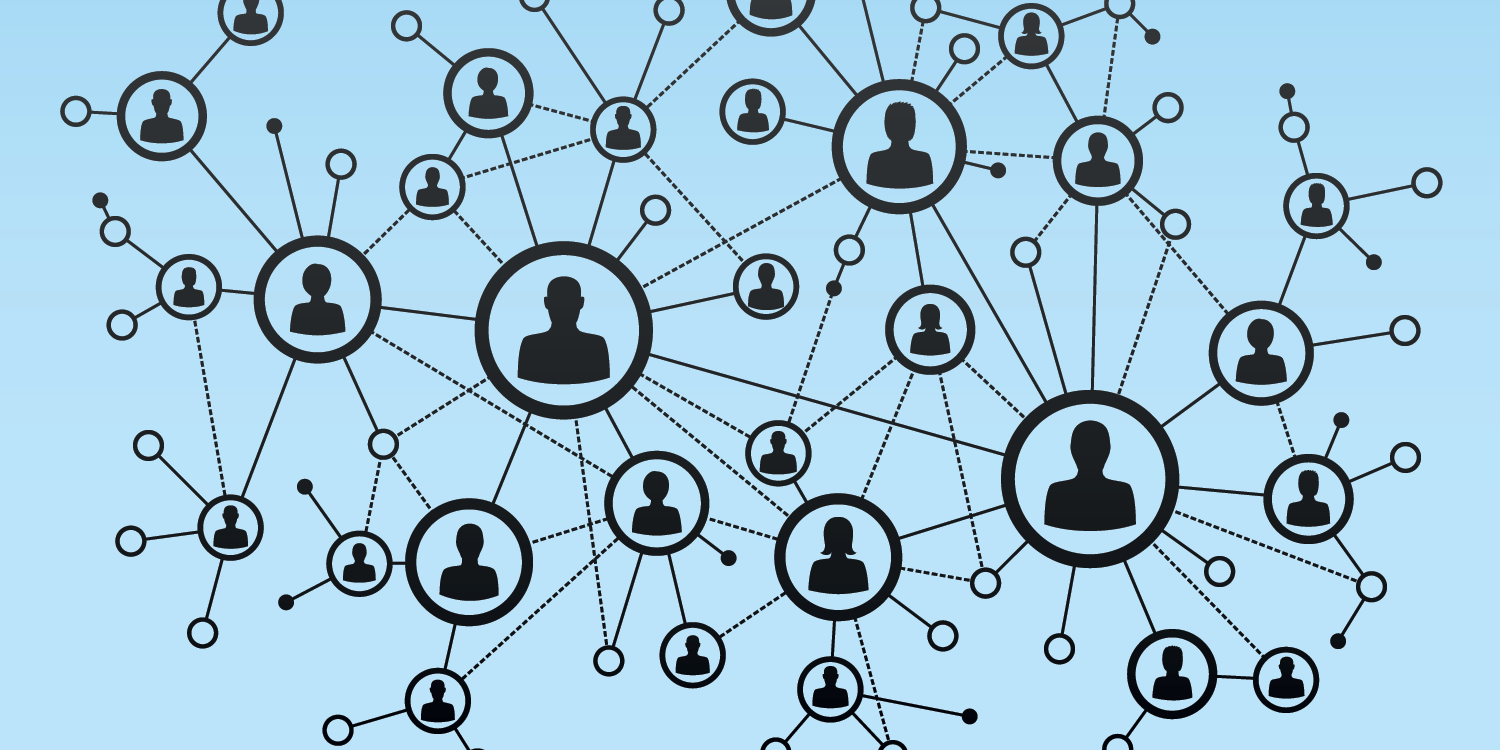Before the pandemic, products that introduced colleagues to each other were still in the early adopter stage and many companies did not pay attention to employee connections because they did not show a short-term impact on their organizations. However, after the pandemic, social isolation became an urgent issue for companies. In almost every company, the resultant lack of co-worker interactions showed up as a lack of collaboration, productivity, or happiness.
However, a product like LEAD.bot is not just a fun tool for companies to plug in for such urgent usage. There is a lot of scientific research behind the fundamentals. We would like to share the research behind our idea of building LEAD.bot and tell you why an organization-wide LEAD.bot can actually help you improve your company’s bottom line by facilitating connections across organizational boundaries. Unlike traditional solutions such as Donut or Coffeepals, LEAD.bot goes beyond being a virtual coffee app, by proactively supporting a vibrant, connected, and engaged remote or hybrid work environment.By seamlessly integrating with popular communication platforms such as Slack and Microsoft Teams, LEAD.bot is designed to support the contemporary demands of remote and hybrid workspaces.
If you attend HR conferences or study people analytics, you probably know that many global fortune 500 companies have people analytics departments. These companies know that they can identify true influencers and energizers through an organizational network analysis (ONA). ONAs track and map day-to-day workflows, collaboration, and expertise sharing enterprise-wide, and help to understand how an organization really works.
Before we get into why we built LEAD.bot, we would like to get into a deeper explanation of what ONA is, so you understand the idea of LEAD.bot was like a no-brainer.
Firstly, What is a virtual coffee app?
A virtual coffee app is a digital platform designed to foster casual interaction among team members within a company. It works by randomly pairing colleagues for virtual chats or meetings, creating an environment similar to spontaneous coffee breaks in a physical office setting.
Why can virtual coffee break help with change management in talent development?
Virtual coffee breaks can significantly aid change management in talent development as they provide an informal setting where employees can discuss ideas, share knowledge, and build relationships. This fosters a sense of unity and open communication, which is essential for embracing organizational changes. Moreover, these interactions can reveal hidden talents or ideas, promoting continuous learning and innovation within the company. This can lead to more adaptive and resilient teams, better equipped to handle change and thrive in a dynamic business environment.
What you do mean data-driven employee matching (virtual coffee session)?
Data-driven employee matching for virtual coffee sessions refers to the use of data and analytics to match employees for these casual meetups. This approach goes beyond random pairing, taking into consideration factors like department, role, tenure, interests, and previous interactions to create meaningful matches. The aim is to foster diverse connections, promote cross-functional collaboration, and enhance knowledge sharing within the organization. This data-driven approach can lead to more enriching conversations during virtual coffee breaks, enhancing the overall employee experience and driving organizational performance.
Data-driven matching involves using technology to create meaningful connections between employees for virtual coffee sessions or mentoring. It uses variables such as roles, interests, and department affiliations for matchmaking. The data from these pairings is vital for people analytics, offering insights into organizational collaboration patterns. This information can guide strategic decision-making, improve team cohesion, and enhance talent development. Moreover, the qualitative data from these sessions can reveal employees’ sentiments, engagement levels, and areas of potential improvement. These insights support HR teams in proactively managing the workplace environment.
What is people analytics?
People analytics, also known as HR analytics or talent analytics, is the method of using data analysis on people-related issues to help make informed decisions. It can involve analyzing employee performance, turnover rates, hiring metrics, employee engagement, and more, with the goal of improving organizational effectiveness.
Why understand employee connection is important in people analytics?
Next, let’s understand employee connections through ONA People Analytics
Employees are not just connected through work, but also through their personal social activities within the company. The various types of connections among employees form a collaboration network, and based on how individuals are connected, their roles in the collaboration network differ.
Organizational network analysis (ONA) is the process of understanding this network. ONA measures and graphs patterns of collaboration by examining the strength, frequency, and nature of interactions between people in networks. It provides valuable insights into how information and communication flow within the organization and how teams and individuals collaborate with each other.
Through ONA, leaders can gain answers to important questions such as:
• How do the information and communication flow in the organization?
• How do teams and individuals collaborate with each other?
• Can we identify the most influential employees or teams and quantify their comparative impact?
• Who has been the most affected due to the pandemic?
• Are there signs of burnout?
• Are some employees at a higher risk of exit?
• Can we help employees be more productive?
Can AI help in customizing employee engagement strategies and boost retention rates?

Depending on the type of roles in the ONA, the way to engage and retain those types of employees is different, LEAD.bot uses sophisticated AI algorithms to identify these roles and customize employee engagement strategies, which significantly boosts retention and productivity within organizations.
Many companies, including industry leaders like Google, Salesforce, and Amazon, have recognized the value of organizational network analysis (ONA) in evaluating how individuals contribute within an organization. ONA provides a valuable perspective on collaboration dynamics. Alongside ONA, organizations can leverage strategies such as using AI tools for change management to enhance their organizational development efforts. AI plays a crucial role in analyzing and visualizing complex employee network data and sentiment data, eliminating the need for expensive consulting firms and extensive interviews. With AI, organizations can efficiently gather insights and receive recommendations for their organizational development and job design strategies.
When conducting ONA, AI technologies make the process more accurate and faster. AI categorizes the various network roles, such as connectors, brokers, gatekeepers, chokepoints, central actors, and outliers, which are crucial for organizations to recognize and understand.
What are these various network roles in ONA that AI helps to identify?
• Connectors: Connectors are individuals who put in relation to many members of the network.
• Brokers: Brokers are connectors who connect different groups/teams/clusters within the network.
• Gatekeepers: Individuals who control the interactions and flow of information going to their networks.
• Chokepoints: Points in the network where the flow of interactions or information is slowed down or stopped.
• Central actors: Highly connected Individuals with a high degree of “centrality”.
• Outlier / peripheral actors: Peripheral team members who have limited connections with most of the network.
By comprehending these roles and their impact on collaboration, organizations can develop tailored strategies for engaging and retaining different types of employees. LEAD.bot stands out from other similar apps by offering highly customizable features and using artificial intelligence to identify and engage different roles within the organization, thereby significantly increasing employee retention and productivity. Recognizing and rewarding influencers and connectors can foster a more inclusive and collaborative work environment. Introducing isolated employees to new connections can mitigate their potential isolation and unlock their untapped potential. This understanding of the network can be further enhanced by incorporating principles of organization development, such as utilize software that uses AI to help with the change management.
In order to effectively capitalize on these insights, companies can deploy tools like LEAD.bot. This application is expertly designed to pinpoint employees’ needs and foster social interactions. As an adept app in Slack and an app in Microsoft Teams, LEAD.bot’s seamless integration with existing communication platforms makes it a convenient and efficient tool for bolstering intra-organizational connections.
Additionally, LEAD.bot goes a step further with its unique feature of virtual coffee meetups. This capability goes beyond the typical virtual coffee app, catalyzing organic conversations and fostering a sense of community among dispersed and hybrid teams. This is achieved through LEAD.bot’s ability to identify individuals who naturally excel in connecting with others, while providing resources to augment their engagement.
Furthermore, LEAD.bot can assist in managing connection overload by spreading connection requests amongst those who can help lighten the load for heavily connected individuals. This holistic approach ensures an evenly distributed network, leading to a more harmonious and engaged workforce. As the LEAD.bot team, we don’t just provide tools for facilitating communication; we help companies identify their change management needs for organizational development, ensuring an effective transformation that aligns with their unique operational objectives.
While it may be challenging to virtualize the complete collaboration network through data analysis alone, empowering employees to take action themselves is crucial. Offering options such as virtual coffee meetups, executive lotteries, peer mentorship, and diversity, equity, and inclusion (DE&I) discussions provides employees with opportunities to connect and contribute in meaningful ways. No one will use a traditional corporate social network product (such as Yammer), That’s why we strategically designed LEAD.bot to blend seamlessly within your existing communication platforms, like Slack and Microsoft Teams. As an advanced app in Slack and app in Microsoft Teams, LEAD.bot offers the advantage of direct integration, eliminating the need for new, unfamiliar platforms. This effective synergy enables organizations to kickstart tailored employee pairings and facilitate guided dialogues. As a result, it significantly simplifies the process for employees to actively participate and enrich their collaboration networks.
How can this virtual coffee app enhance your company’s collaboration network in 6 essential ways?
• Promoting rapid innovation: organizations can spark innovation by removing silos, combining expertise, and accelerating decision-making.
• Introducing new leaders: leaders will be able to identify culture champions as well as people with various talents, such as community building, people operation, storytelling, etc.
• Driving diversity, equity, and inclusion: employees who aren’t well connected in their networks may be underutilized or at risk of departure. Having ERGs or casual guided conversations to include all races, genders, identities, abilities, or other demographics, you can find an emerging opportunity for the troubling patterns.
• Improving employee well-being: well-being programs often focus on physical and mental health, but rarely attempt to address major stressors at work such as collaborative overload, or isolation. Implementing opportunities for casual peer-to-peer check-ins will not only have a positive impact on their well-being but also mitigate turnover risk.
• Leading a culture renovation: companies spend a tremendous amount of time and effort attempting to change culture, yet research shows that only 15% succeed. Often, the attempt fails because companies don’t take the time to properly identify influencers, energizers, and blockers within their workforce. By leading LEAD.bot implementation, you can identify connectors early in the process. The culture change team can build support through influencers—who may not be obvious functional leaders—and work to win over or work around potential naysayers.
• Managing a merger or acquisition: Unsuccessful acquisitions are often the result of poor cross-cultural strategies. LEAD.bot can help introduce influential people within both organizations and can be engaged to act as leaders for the transition.
This approach positions LEAD.bot as a more comprehensive and flexible alternative to similar apps such as Donut or Coffeepals. Its robust features go beyond just facilitating virtual coffee meetups, truly embodying the essence of an advanced collaboration tool.
LEAD.bot equips employees with the resources needed to kickstart casual conversations with paired colleagues or groups, nurturing spontaneous exchanges within Slack and Microsoft Teams channels. This functionality places LEAD.bot on a pedestal, transcending the capabilities of a typical virtual coffee app. It emerges as a comprehensive solution that underpins the formation of meaningful internal relationships and fosters collaboration, offering a superior alternative to apps like Donut, Coffeepals, and similar tools.
Such authentic interactions encouraged by LEAD.bot serve as the bedrock for fortifying company culture, effectively bridging gaps when employees are spread across varying geographical locations and time zones. These watercooler conversations create a laid-back atmosphere conducive for employees to connect seamlessly.
As the clock ticks, the network sizes, densities, and various characteristics of individuals inevitably evolve. This is where the LEAD ONA platform steps in. It keenly observes these changes and responds accordingly, empowering leaders to develop a comprehensive understanding of their organization.
Furthermore, LEAD.bot incorporates an advantageous feature known as the Pulse Survey. This innovative feature equips organizations with the ability to amass valuable insights by directing specific questions towards precise demographics more frequently. For example, you can ask 5 questions a time bi-monthly. This capability bestowed by the Pulse Survey assists companies in corroborating certain data points, enabling them to gain a comprehensive understanding of their workforce.
In tandem with these casual conversations, the Pulse Surveys play a significant role, allowing teams and organizations to make optimum use of LEAD.bot. The combined power of these elements facilitates the molding of their organizational network in such a way that bolsters collaboration and motivates individuals to effectively meet their objectives, as depicted in the subsequent illustration.
One of the recent enhancements to LEAD.bot is its new hire onboarding product. This fresh addition to the bot provides a structured approach to onboarding, helping new hires get acquainted with their team and the organization as a whole. This onboarding feature ensures that new recruits are paired with a buddy, introduced to their team, and provided with managerial coaching. These supportive elements streamline the integration of new hires into the company culture and its operations, ensuring a seamless transition.
To further foster the professional growth and job satisfaction of new employees, LEAD.bot conducts systematic check-ins at 30, 60, and 90-day intervals. These check-ins ensure that the new hires are settling well into their roles and any potential issues or concerns are addressed proactively. Thus, LEAD.bot goes the extra mile to ensure new hires feel welcomed, connected, and supported from the get-go, enhancing their productivity and overall job satisfaction.”

How Can Integrating a Virtual Coffee App in Microsoft Teams Boost Your Team’s Engagement Seamlessly?
- Ease of Use: The integration of a virtual coffee app into already familiar platforms like Slack or Microsoft Teams allows users to enjoy its features without having to learn a new tool. It’s as simple as adding a bot to a conversation.
- Increased Participation: As employees are already using these platforms for their daily communications, they are more likely to participate in virtual coffee chats when they are accessible from the same environment.
- Real-time Collaboration: The integration facilitates real-time collaboration and spontaneous discussions, similar to having a coffee chat in a physical office.
- Enhanced Communication: The integration allows for more diverse and frequent interactions among team members, improving overall communication and team dynamics.
- Data Collection: With an integrated virtual coffee app, organizations can leverage the data from these interactions for people analytics, gaining insights into collaboration dynamics and employee sentiment.
- Employee Engagement: By fostering casual interactions and connections, the integration can boost employee engagement and satisfaction.
- Cost and Time Efficient: Using an integrated virtual coffee app eliminates the need for switching between different platforms, thereby saving time and improving productivity.
At LEAD, our mission is to foster employee development and transform companies. While LEAD.bot facilitates conversations between unfamiliar colleagues, the cumulative impact of these pairings can lead to profound organizational transformations that directly influence cross-team functionality and communication channels. LEAD.ONA tracks organizational development changes over time and supports you in implementing effective change management strategies, all powered by our advanced people analytics and AI technologies!
Read more about:
What is People Analytics and What Does LEAD Offer?
Better People Analytics with Organizational Network Analysis







